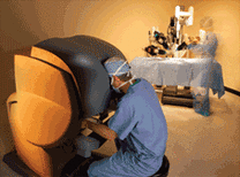Robotic Surgery
What Is Robotic Surgery?
 Northwestern Medicine surgeons are dedicated to offering less invasive alternatives to traditional procedures for our patients. Robotic surgery provides a number of benefits for patients including:
Northwestern Medicine surgeons are dedicated to offering less invasive alternatives to traditional procedures for our patients. Robotic surgery provides a number of benefits for patients including:
- A shorter hospital stay
- Fewer complications
- Decreased pain postoperatively
- Minimal scarring
- Less risk of infection
- Less blood loss and fewer transfusions
- Faster recovery
- Faster return to normal activities
- Improved quality of life
da Vinci® Surgical System
Northwestern Medicine surgeons make use of the innovative da Vinci® Surgical System to help provide the precision needed for a variety of complex procedures, including surgery for many cancers, urologic surgery, cardiovascular surgery, thoracic surgery, gynecologic surgery, and general surgeries.
How the system works
The da Vinci® Surgical System works in much the same way as a traditional laparoscopic procedure. Surgeons make small incisions, and a camera lens with a light source and instruments are inserted into your body through small tubes. However, instead of directly manipulating the laparoscopic instruments, surgeons sit at a nearby console and view a magnified three-dimensional image of the surgical site.
Controls on the console allow physicians to move surgical instruments inside your body with far more precision, stability, and dexterity than if they were holding the instruments in their hands. In fact, surgical instruments can be rotated up to 540 degrees—an impossibility for the human wrist.
The da Vinci® Surgical System also allows surgeons to view the surgical site with far greater clarity. Features of the da Vinci® System include:
- Camera with a high-resolution, 3D image
- Surgeon-controlled camera that can be moved to get the best view possible
- Magnification controlled by the surgeons
Laparoscopic surgery
Laparoscopic surgery, also known as minimally invasive surgery, allows surgery to be performed without making long incisions in the body. Instead, surgeons make several small incisions, typically under an inch in length.
A thin, lighted tube with a camera at the tip, called a laparoscope, is inserted into one of the openings. The camera allows surgeons to view the desired surgical site on a large, flat-screen monitor. Tiny surgical instruments are inserted through the remaining incisions, which physicians manipulate to perform delicate procedures. In orthopaedics, this type of surgery is called arthroscopy.
Types of laparoscopic procedures
With ongoing advancements in surgical technology and the exceptional skill of our surgeons many areas of surgery can now be performed laparoscopically, including:
- Appendix
- Bladder
- Bowel
- Cancerous tumors
- Colon
- Esophagus
- Gallbladder
- Kidney
- Liver
- Lung
- Orthopaedic joints
- Pancreas
- Prostate
- Spine
- Stomach
- Uterus
- Weight loss
Benefit to you
Smaller incisions mean that less skin, muscle and other tissue are cut during your surgery, so you heal faster and the risk for complications is reduced. Typically, laparoscopic patients leave the hospital one to three days sooner than those who have traditional open surgery. Many laparoscopic surgeries can be performed on an outpatient basis, allowing you to return home the very same day.

